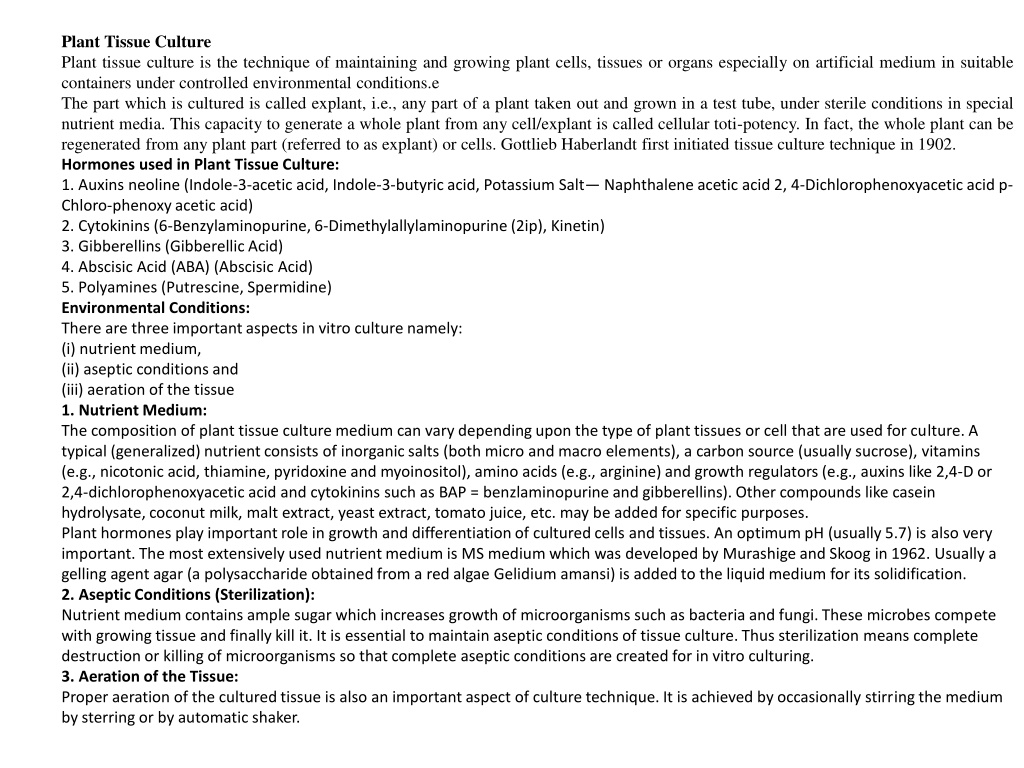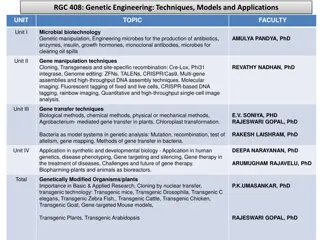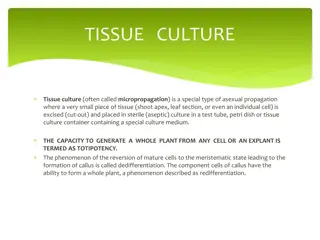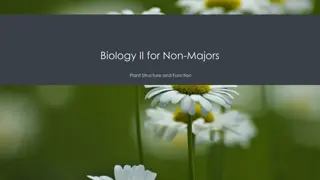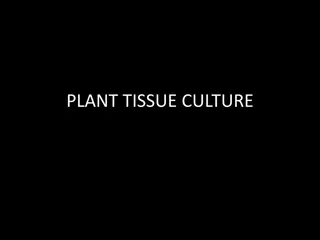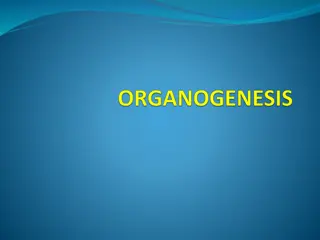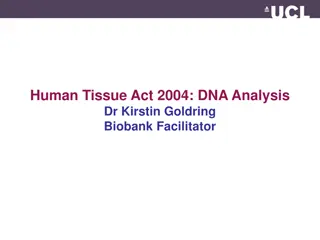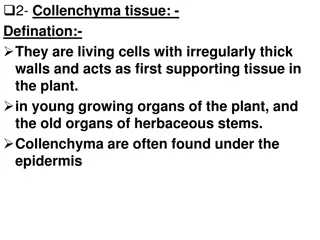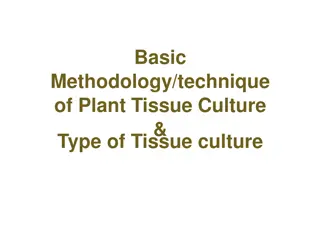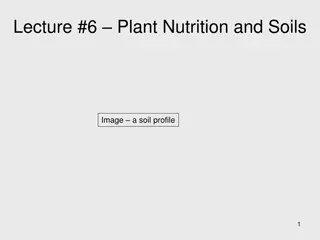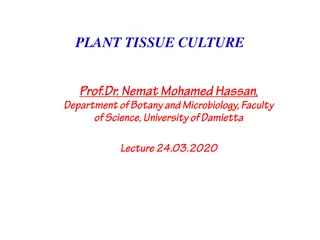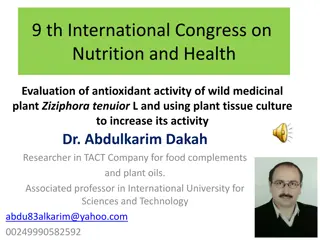Understanding Plant Tissue Culture: Techniques and Applications
Plant tissue culture involves maintaining and growing plant cells, tissues, or organs in artificial mediums under controlled conditions. It allows the regeneration of whole plants from small plant parts or cells. Hormones like auxins, cytokinins, and gibberellins are used in the process. Proper environmental conditions, including aseptic techniques and nutrient mediums, are crucial for successful plant tissue culture. Different methods and types of plant tissue culture, such as callus and suspension cultures, are utilized for various purposes in plant research and propagation.
Download Presentation

Please find below an Image/Link to download the presentation.
The content on the website is provided AS IS for your information and personal use only. It may not be sold, licensed, or shared on other websites without obtaining consent from the author. Download presentation by click this link. If you encounter any issues during the download, it is possible that the publisher has removed the file from their server.
E N D
Presentation Transcript
Plant Tissue Culture Plant tissue culture is the technique of maintaining and growing plant cells, tissues or organs especially on artificial medium in suitable containers under controlled environmental conditions.e The part which is cultured is called explant, i.e., any part of a plant taken out and grown in a test tube, under sterile conditions in special nutrient media. This capacity to generate a whole plant from any cell/explant is called cellular toti-potency. In fact, the whole plant can be regenerated from any plant part (referred to as explant) or cells. Gottlieb Haberlandt first initiated tissue culture technique in 1902. Hormones used in Plant Tissue Culture: 1. Auxins neoline (Indole-3-acetic acid, Indole-3-butyric acid, Potassium Salt Naphthalene acetic acid 2, 4-Dichlorophenoxyacetic acid p- Chloro-phenoxy acetic acid) 2. Cytokinins (6-Benzylaminopurine, 6-Dimethylallylaminopurine (2ip), Kinetin) 3. Gibberellins (Gibberellic Acid) 4. Abscisic Acid (ABA) (Abscisic Acid) 5. Polyamines (Putrescine, Spermidine) Environmental Conditions: There are three important aspects in vitro culture namely: (i) nutrient medium, (ii) aseptic conditions and (iii) aeration of the tissue 1. Nutrient Medium: The composition of plant tissue culture medium can vary depending upon the type of plant tissues or cell that are used for culture. A typical (generalized) nutrient consists of inorganic salts (both micro and macro elements), a carbon source (usually sucrose), vitamins (e.g., nicotonic acid, thiamine, pyridoxine and myoinositol), amino acids (e.g., arginine) and growth regulators (e.g., auxins like 2,4-D or 2,4-dichlorophenoxyacetic acid and cytokinins such as BAP = benzlaminopurine and gibberellins). Other compounds like casein hydrolysate, coconut milk, malt extract, yeast extract, tomato juice, etc. may be added for specific purposes. Plant hormones play important role in growth and differentiation of cultured cells and tissues. An optimum pH (usually 5.7) is also very important. The most extensively used nutrient medium is MS medium which was developed by Murashige and Skoog in 1962. Usually a gelling agent agar (a polysaccharide obtained from a red algae Gelidium amansi) is added to the liquid medium for its solidification. 2. Aseptic Conditions (Sterilization): Nutrient medium contains ample sugar which increases growth of microorganisms such as bacteria and fungi. These microbes compete with growing tissue and finally kill it. It is essential to maintain aseptic conditions of tissue culture. Thus sterilization means complete destruction or killing of microorganisms so that complete aseptic conditions are created for in vitro culturing. 3. Aeration of the Tissue: Proper aeration of the cultured tissue is also an important aspect of culture technique. It is achieved by occasionally stirring the medium by sterring or by automatic shaker.
Methods of Plant Tissue Culture: Plant tissue culture includes two major methods: (A) Type of in vitro growth-callus and suspension cultures. (B) Type of explant single cell culture, shoot and root cultures, somatic embryo culture, meristem culture, anther culture and haploid production, protoplast culture and somatic hybridisation, embryo culture, ovule culture, ovary culture, etc. Types of Plant Tissue Culture: Callus and Suspension Cultures: In callus culture, cell division in explant forms a callus. Callus is irregular unorganised and undifferentiated mass of actively dividing cells. Darkness and solid medium gelled by agar stimulates callus formation. The medium ordinarily contains the auxin, 2,4-D, (2, 4- dichlorophenoxy acetic acid) and often a cytokinin like BAP (Benzyl aminopurine). Both are growth regulators. This stimulates cell divison in explant. Callus is obtained within 2-3 weeks. A suspension culture consists of single cells and small groups of cells suspended in a liquid medium. Usually, the medium contains the auxin 2,4-D. Suspension cultures must be constantly agitated at 100-250 rpm (revolutions per minute). Suspension cultures grow much faster than callus culture. Sub culturing: If tissue cultures are kept in the same culture vessel, they die in due course of time. Therefore, cells/tissues are regularly transferred into new culture vessels containing fresh media. This process is called sub culturing. It is important to note that during subculture; only a part of the culture from a vessel is transferred into the new culture vessel. The callus and suspension cultures may be used to achieve cell biomass production, regeneration of plantlets, production of transgenic plants and isolation of protoplasts.
Meristem Culture: Meristem is a localized group of cells, which are actively dividing and undifferentiated but ultimately giving rise to permanent tissue. Although the plant is infected with a virus, yet the meristem is free of virus. Therefore, meristem can be removed and grown in vitro to obtain virus free plants. Cultivation of axillary or apical shoot meristems is called meristem culture. The apical or axillary meristems are generally free from virus. Meristem culture involves the development of an already existing shoot meristem and subsequently, the regeneration of adventitious roots from the developed shoots. It usually does not involve the regeneration of a new shoot meristem. The explants commonly used in meristem culture are shoot tips and nodal segments. These explants are cultured on a medium containing a cytokinin (generally BAP). The plantlets thus obtained are subjected to hardening and, ultimately, established in the field. Meristem culture is carried out in Potato, Banana, Cardamom, Orchids (protocorm stage), Sugarcane, Strawberry, Sweet Potato, etc. It is used in (i) Production of virus-free plants like potato, sugarcane, banana and apple, (ii) Germplasm conservation, (iii) Production of transgenic plants, (iv) Rapid clonal multiplication.
Micro propagation: Micropropagation is the tissue culture technique used for rapid vegetative multiplication of ornamental plants and fruit trees by using small sized explants. Because of minute size of the propagules in the culture, the propagation technique is named as mircopropagation. This method of tissue culture produces several plants. Each of these plants will be genetically identical to the original plant from where they were grown. The genetically identical plants developed from any part of a plant by tissue culture/micropropagation are called somaclones. The members of a single somaclone have the same genotype. This micropropagation is also known as somaclonal propagation. It is the only process adopted by Indian plant biotechnologists in different industries mainly for the commercial production of ornamental plants like lily, orchids, Euca lyptus, Cinchona, Blueberry, etc. and fruit trees like tomato, apple, banana, grapes, potato, citrus oil palm, etc. There are four defined steps in micro propagation method. These are: (i) Initiation of culture from an explant like shoot tip on a suitable nutrient medium. (ii) Shoot formation multiple shoots formation from the cultured explant. (iii) Rooting of shoots rooting of in vitro developed shoots. (iv) Transplantation the hardening of tissue culture raised plants and subsequent transplantation to the field. Advantages of Micro propagation: These are as follows: 1. It helps in rapid multiplication of plants. 2. A large number of plantlets are obtained within a short period and from a small space. 3. Plants are obtained throughout the year under controlled conditions, independent of seasons. 4. Sterile plants or plants which cannot maintain their characters by sexual reproduction are multiplied by this method. 5. It is an easy, safe and economical method for plant propagation. 6. In case of ornamentals, tissue culture plants give better growth, more flowers and less fall-out. 7. Genetically similar plants (somaclones) are formed by this method. Therefore, desirable characters (genetope) and desired sex of superior variety are kept constant for many generations. 8. The rare plant and endangered species are multiplied by this method and such plants are saved. Regeneration of Plantlets: 1. Preparation of Suitable Nutrient Medium: Suitable nutrient medium as per objective of culture is prepared and transferred into suitable containers. 2. Selection of Explants: Selection of explants such as shoot tip should be done. 3. Sterilisation of Explants: Surface sterilization of the explants by disinfectants and then washing the explants with sterile distilled water is essential. 4. Inoculation: Inoculation (transfer) of the explants into the suitable nutrient medium (which is sterilized by filter-sterilized to avoid microbial contamination) in culture vessels under sterile conditions is done.
5. Incubation: Growing the culture in the growth chamber or plant tissue culture room, having the appropriate physical condition (i.e., artificial light; 16 hours of photoperiod), temperature (-26 C) and relative humidity (50-60%) is required. 6. Regeneration: Regeneration of plants from cultured plant tissues is carried out. 7. Hardening: Hardening is gradual exposure of plantlets to an environmental conditions. 8. Plantlet Transfer: After hardening plantlets transferred to the green house or field conditions following acclimatization (hardening) of regenerated plants.
